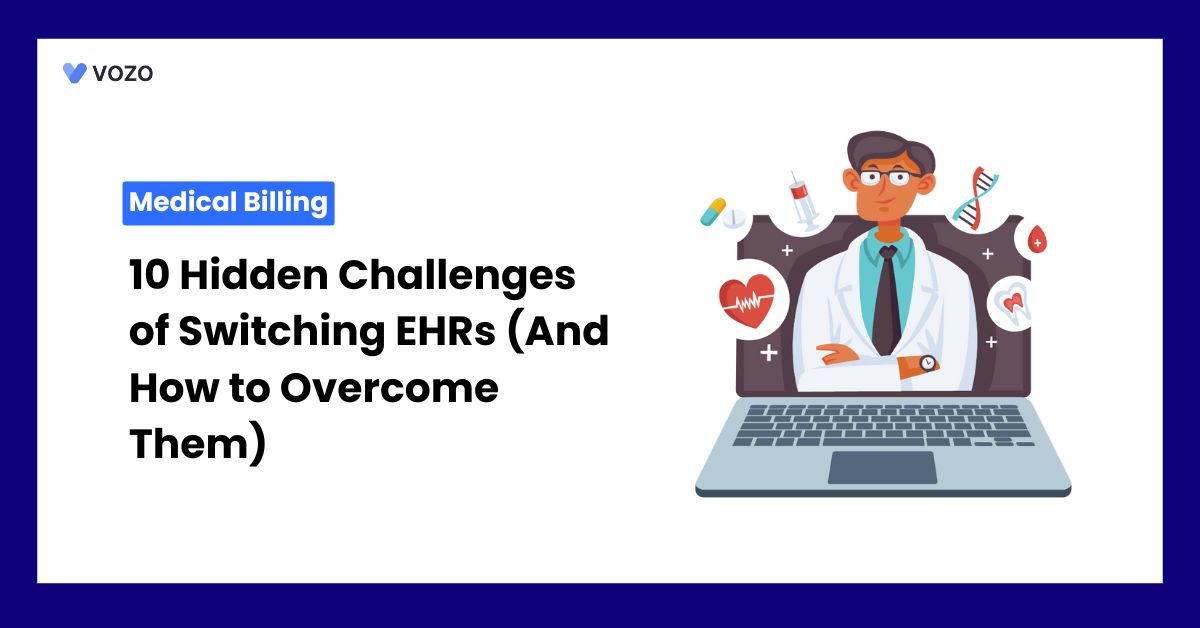10 Hidden Challenges of Switching EHRs (And How to Overcome Them)
Switching EHR systems is challenging. Many healthcare organizations saw unexpected challenges during the system switch. These include data migration failures, resistance to new EHR systems among staff, or disruption of workflow-things that affect the quality of patient care and organizational performance.
If the switch is badly planned, costs may become overrun, compliance risks arise, and physicians may well burn out. On the flip side, with the right level of preparedness and strategic skills, healthcare providers could easily tackle these challenges.
In this blog, we have shared the 10 hidden challenges of EHR migration along with possible solutions that will leave your practice or healthcare facility with a smooth, efficient, and successful transition.
The Growing Need for EHR System Upgrades
The healthcare industry is significantly evolving with high demands. Legacy EHR systems often struggle to meet these advancements. Here are some reasons to upgrade EHR:
- Legacy EHR often fails to integrate with modern third-party applications.
- New healthcare regulations require systems to maintain higher standards.
- AI-powered automation, predictive analytics, and cloud-based EHR solutions lead to better insights, scalability, and patient outcomes.
- Outdated EHRs can be hefty, slow, and not intuitive.
Healthcare practices need to be updated and advanced to stay competitive.
And outdated EHR systems always hold you back. Healthcare organizations must proactively evaluate their current EHR capabilities and consider timely upgrades.
Related: The 8-Step Checklist to Consider Before Implementing EHR
Why EHR Migration is More Challenging Than it Seems
Updating to newer EHR systems always promises a better and more positive impact on operation and patient care. However, the migration process itself has numerous technical, operational, and financial challenges. Some common reasons why EHR migration is more complex than anticipated include:
- Moving vast amounts of patient records comes with the risk of data loss.
- A new system often requires significant workflow restructuring.
- Staff members must unlearn previous workflows and adapt to new interfaces.
- Beyond software costs, training, downtime, additional IT support, and integration efforts can lead to budget overruns.
These are some of the reasons why the EHR migration process becomes more challenging. To overcome these challenges. Healthcare practices need to adopt a structured and strategic approach.
10 Hidden Challenges of Switching EHRs (Solutions to Solve Them)
While the benefits of migrating to EHRs are substantial, the migration process presents several hidden challenges. Here are the 10 hidden challenges and practical solutions to navigate them effectively.
Challenge #1. Data Migration Complexity
Transferring large amounts of patient data from legacy systems to a new EHR is complicated. Challenges include data loss, corruption, and ensuring compatibility between differing data formats. For example, differences in data mapping can result in vital patient information being misplaced or misread.
Solution:
- Begin with a thorough evaluation of existing data to identify essential information and eliminate redundancies.
- Develop a detailed plan that aligns data fields from the old system to the new one.
- Conduct testing phases to identify discrepancies early and ensure data integrity post-migration.
Challenge #2. Staff Training and Adaptation
Introducing a new EHR system necessitates comprehensive staff training. Without adequate preparation, staff may experience frustration. This might lead to decreased productivity and potential errors while using the system.
Solution:
- Engage with staff to provide clear information about the transition process and timelines.
- Develop training sessions that cater to different roles within the organization.
- Offer ongoing assistance post-implementation like help desks or peer support groups.
Challenge #3. Unexpected Costs and Budget Overruns
More than the initial purchase price, EHR transitions can incur hidden expenses. Some of the expenses include data migration fees, extended training periods, and temporary productivity losses.
Solution:
- Take into account all prospective costs, such as hardware upgrades, training, and staff overtime.
- Discuss price structures with EHR providers to uncover hidden fees and look at packaged service choices.
- Set aside a portion of your budget for hidden expenses to avoid financial strain throughout the changeover.
Challenge #4. Downtime and Workflow Disruptions
System downtimes during the transition can disrupt patient care and administrative workflows. This might lead to potential revenue loss and patient dissatisfaction.
Solution:
- Roll out the new system in stages to minimize disruptions and allow for adjustments.
- Establish manual or alternative processes to maintain operations during system downtimes.
- Plan major transition activities during periods of low patient volume to reduce impact.
Challenge #5. Interoperability Challenges with Existing Systems
Ensuring the new EHR integrates seamlessly with existing systems like laboratory information systems or billing software. Compatibility difficulties result in disparities in information and process obstacles.
Solution:
- Evaluate the new EHR’s compatibility with current systems before selection.
- Opt for EHRs that support open standards like HL7 or FHIR to facilitate integration.
- Work closely with vendors to develop custom interfaces or APIs as needed.
Challenge #6. Compliance and Data Security Risks
The shift to a new EHR system may expose the firm to compliance concerns and data security threats. This might risk patient confidentiality and potential legal repercussions.
Solution:
- Make sure the new EHR system is compatible with all relevant healthcare compliances like HIPPA.
- Practices need to implement encryption methods for data at rest and in transit to protect patient information.
- Conduct regular security audits and vulnerability assessments to identify and mitigate potential risks promptly.
Challenge #7. Limited Customization and Functionality Gaps
The new EHR system may lack specific functionalities or customization options necessary to meet the unique needs of the organization.
Solution:
- Conduct a thorough review of organizational requirements to determine critical functionalities and customization needs.
- Collaborate with the EHR provider to create necessary adjustments or find appropriate third-party solutions to fill capability gaps.
- Create a feedback tool for users to report issues and suggest changes.
Challenge #8. Increased Physician Workload and Burnout
Because of the unfamiliarity, physicians may find it more difficult to adapt to a new EHR system. This may lead to provider frustration and exhaustion.
Solution:
- Select an EHR system with an intuitive interface that aligns with clinical workflows
- Leverage features such as voice recognition and customizable templates in the documentation process.
- Assess physician workload and well-being regularly, offering support and making appropriate modifications to avoid burnout.
Challenge #9. Vendor Support and Responsiveness
EHR migrations necessitate consistent vendor assistance to handle technical challenges, customization requirements, and system optimization. A lack of timely vendor assistance can cause extended downtime, user irritation, and higher operational hazards.
Solution:
- Set up clear SLAs with the vendor that specify response times, issue resolution techniques, and escalation procedures.
- Work with vendors who offer 24-hour customer support, dedicated account managers, and on-site assistance during the changeover.
- Schedule regular evaluations with the vendor to evaluate system performance, identify recurring issues, and make necessary modifications.
Challenge #10. Patient Portal Disruptions and Engagement Decline
A well-integrated patient portal is essential for engagement, appointment scheduling, and medical record access. Poorly managed EHR switches might cause disruptions in patient access. This will result in unhappiness and probable compliance issues.
Solution:
- Ensure that all patient data, including historical records, appointment schedules, and communication history, is properly moved without loss or corruption.
- Notify patients about portal changes ahead of time, and provide clear instructions, tutorials, and support channels to help them transition smoothly.
- Provide step-by-step tutorials, FAQs, and dedicated support teams to help patients navigate the new portal.
Related: 10 Major Factors to Consider While Choosing a Patient Portal Platform
Vozo EHR for Your Practice
Want to streamline your practice workflow? Whether you are a small-scale clinic, specialty practice, or large-scale healthcare organization, Vozo Cloud EHR is here for you.
Vozo’s EHR system offers a vast range of benefits for your specialty practice.
- Streamline your specialty practice workflow and speed up the process
- Easy transition from paper workflow to digital workflow
- Provides complete access to the patient’s up-to-date medical records
- Accurate reporting and analytics for better decision-making
- Our Cloud EHR system continues to scale as your healthcare practice grows
- 24/7 Tech support to assist you with any needs or requirements
Our EHR system allows you to manage all patient records under one roof, reducing the heavy workload for your healthcare practice staff.
Trust in Vozo EHR as we reduce your burdens and let you focus more on better patient outcomes.
About the author

With more than 4 years of experience in the dynamic healthcare technology landscape, Sid specializes in crafting compelling content on topics including EHR/EMR, patient portals, healthcare automation, remote patient monitoring, and health information exchange. His expertise lies in translating cutting-edge innovations and intricate topics into engaging narratives that resonate with diverse audiences.













